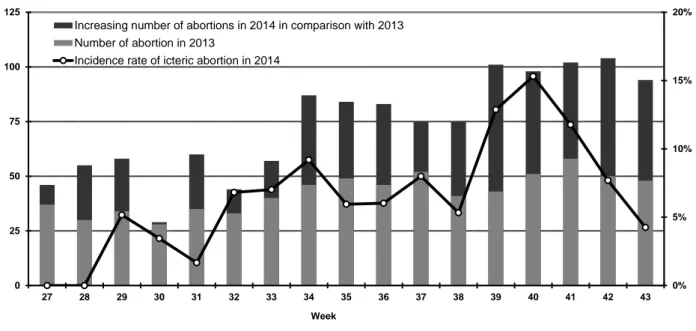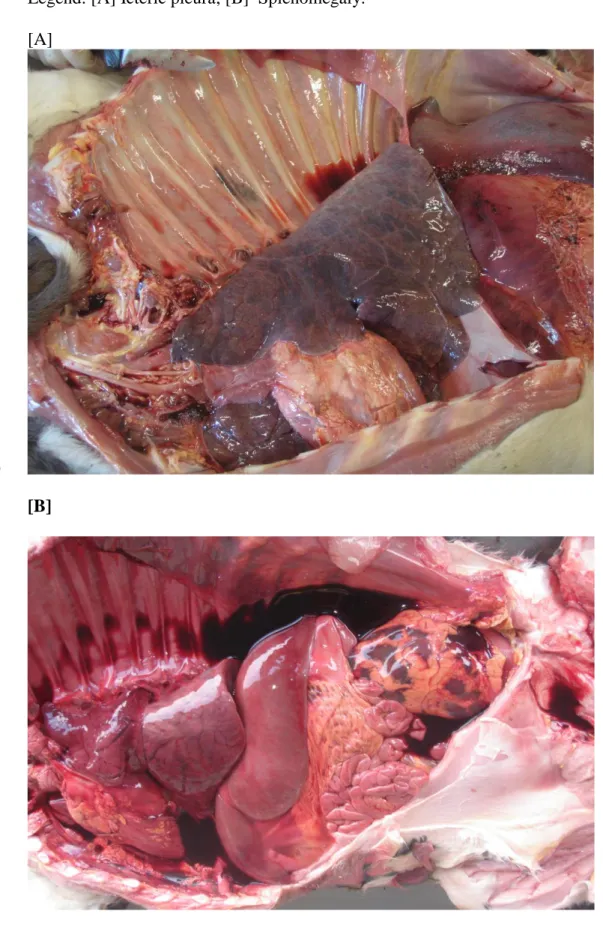Congenital jaundice in bovine aborted fetuses: an emerging syndrome in Southern 1
Belgium 2
3
Delooz Laurent 1,3, *, Mori Marcella 2,*, Petitjean Thierry 1, Evrard Julien 1, Czaplicki 4
Guy 1, Saegerman Claude 3 5
6
(1) Association Régionale de Santé et d’Identification Animales (ARSIA), Département Santé 7
Animale, B-5590 Ciney, Belgium 8
(2) Veterinary and Agrochemical Research Centre (CODA-CERVA), Bacterial zoonoses of 9
livestock, Brussels, Belgium 10
(3) Research Unit of Epidemiology and Risk Analysis applied to veterinary science (UREAR-11
ULg), Fundamental and Applied Research for Animals & Health (FARAH), Faculty of 12
Veterinary Medicine, University of Liege, Liege, Belgium 13
14
*Both first authors contributed equally to the work 15
16
Corresponding author: Dr. Laurent Delooz, E-mail: laurent.delooz@arsia.be; Dr. Marcella 17
Mori, E-mail: marcella.mori@coda-cerva.be (for leptospirosis diagnosis). 18
19
Abstract 20
Southern Belgium faces an unusual recent increase of icteric bovine aborted fetuses. In the 21
necropsy room, the majority of fetuses presented jaundice and splenomegaly. Despite a wide 22
range of analyses, no definitive cause of abortion has yet been established but leptospirosis 23
hypothesis. This first description of cases will help veterinary practitioners to recognize more 24
cases and to conduct those to the laboratory for future investigations. 25
26
Keywords: Icteric abortion, Bovine, Emerging syndrome, Leptospirosis, Belgium 27
28
Southern Belgium (Wallonia region) faces an unusual situation with the drastic increase of 29
congenital jaundice cases in bovine aborted fetuses. This unexpected event was notified on 30
the 1st September 2014 by the Regional Association for Animal Registration and Health 31
(ARSIA) to the competent authority, i.e. the Federal Agency for the Safety of the Food Chain 32
(FASFC). 33
In Belgium, as in many other European countries, the reporting of bovine abortions and the 34
subsequent analysis of their products for brucellosis is mandatory. An additional standardized 35
panel of analyses, which is designed to screen a large number of pathogens associated with 36
bovine abortion (see below) and routinely applied on fetuses submitted to the ARSIA 37
laboratory, failed to identify the origin of these abortions. 38
During the last six years, cases of abortions with jaundice have been notified but the monthly 39
incidence of these cases never exceeded 4% or more than 3 absolute cases per month. Since 40
July 2014, more than 90 new cases of bovine aborted fetuses with jaundice have been 41
reported by ARSIA pathologists, with a maximum monthly incidence of 9.37%. The 42
incidence rate of icteric bovine aborted fetuses was significantly higher in September 43
compared to the mean monthly incidence of the six previous years (Linear regression; p-value 44
= 0.04). Concomitantly, an approximate 70% increase in the number of reported abortions 45
was also observed compared to the previous year for the months of July, August and 46
September. The peak of the weekly incidence was reached in the first week of October 2014 47
(15/98 abortions; 15.31%) (Figure 1). Then, the rate of fetuses with jaundice dropped to 48
4.36% three weeks after peaking whereas the number of reported abortions remained above 49
the 2013 level for the same reporting period. In addition, abortions with jaundice were not 50
distributed homogeneously in the study area (Fisher's exact test, p-value = 0.03). There were 51
significantly more cases in Hainaut (N = 29) and Namur (N = 17) provinces than in the three 52
other provinces (N = 13) (Fisher's exact test, p-value = 0.002). From the affected farms, only 53
one case of bovine aborted foetus was identified in 95% of the farms and two case in the 54
remaining other 5%, which appears to be important information with regard to the 55
epidemiology of the disease. 56
In the necropsy room, the majority of icteric bovine fetuses presented splenomegaly 57
(Figure 2) and/or liver parenchyma uniformly coppered and/or perirenal hemorrhage and/or 58
hemorrhagic edema; significantly there was an absence of inflammation within the lymph 59
nodes. Fetal membranes appeared normal, transparent and thin. Histology demonstrated 60
abnormalities in the liver where periportal lymphoplasmacytic infiltration and deposition of 61
gold-brownish pigments in hepatocytes or in the bile canaliculi were observed. A small 62
number (about 4%) of these abortions have breathed but they died within few hours after 63
birth. All fetuses were submitted for brucellosis analysis and an additional standardized panel 64
of analyses designed to extend the diagnosis of bovine abortions to other diseases than 65
brucellosis, and involving methods for the direct and/or indirect detection of pathogens, such 66
as bacteria (Listeria monocytogenes, Salmonella Dublin, Coxiella burnetii, Anaplasma 67
phagocytophilum, Bacillus licheniformis, Campylobacter spp., Leptospira borgpetersenii and
68
interrogans serovar hardjo), parasites (Neospora caninum) and viruses (bluetongue virus
69
serotype 8 (BTV-8), bovine herpes virus 4 (BoHV-4), bovine viral diarrhea virus (BVDV) 70
and Schmallenberg virus (SBV)), several mycotic agents, and numerous other opportunistic 71
bacteria. Anamnestic information recorded by veterinary practitioner in a standardized form 72
dedicated to the bovine abortion notification revealed that aborted animals did not show any 73
particular clinical sign and did not receive medication during pregnancy. In addition, in 74
comparison with control cases (non-icteric bovine aborted fetus submitted to the laboratory 75
during the same period), aborted cows did not have any contact with animals purchased or 76
with environmental specific risks (e.g. wood, hedges, rivers and ponds). However, it was 77
possible to demonstrate that more than 95% of these cases occurred during the last third of 78
gestation and the Blue Belgian cattle was more likely to be affected by this syndrome. 79
Complementary laboratory diagnosis for bovine leptospirosis performed at the 80
national reference laboratory with the microscopic agglutination test (diagnostic threshold 81
dilution of 1/100) and covering a higher panel of serogroups indicated that 18/19 (95%) cows 82
giving icteric abortions had antibodies against Leptospira serogroups Australis or 83
Grippotyphosa. In this group, 13/18 (72%) of positive cows had titres > 1/500. Serological 84
analyses in control cows (those giving non-icteric presentation of abortions at time period as 85
the previous group) revealed antibodies against Leptospira serogroup Grippotyphosa in 6/22 86
(27%) with only 1/22 (4.5%) with titre >1/500, serogroup Autumnalis in 1/22 (4.5%) and titre 87
>1/500, and serogroup Ballum in 2/22 (9%) with 0/22 with titre >1/500. The odds ratio to 88
obtain a positive result for Leptospira serogroups in cows giving icteric presentation of 89
abortions versus cows giving non-icteric presentation abortions was 48 (95% confidence 90
interval [CI]: 5-442) and 55 (95% CI: 6-521) according to the diagnostic threshold dilution of 91
1/100 and 1/500, respectively. 92
The etiologies for congenital bovine fetal anomalies can be divided into heritable, 93
toxic, nutritional, and infectious categories. Although antibodies against Leptospira 94
serogroups Australis and Grippotyphosa were observed at high titers in cows delivering 95
icteric abortions, further investigations are needed to confirm leptospirosis as the definitive 96
diagnosis. Therefore, until now, the exact origin of this emergence remains unknown but 97
other epidemiological investigations and diagnostic analyses are underway. 98
We hope that such description of field clinical observations made on this first serial icteric 99
abortion cases will help the veterinary practitioners to recognize more suspected cases and to 100
conduct those to the laboratory for future investigations. 101
Figure 1. Trends of icteric bovine aborted fetuses rate and the absolute number of abortions 102 notified 103 0% 5% 10% 15% 20% 0 25 50 75 100 125 27 28 29 30 31 32 33 34 35 36 37 38 39 40 41 42 43 Week
Increasing number of abortions in 2014 in comparison with 2013 Number of abortion in 2013
Incidence rate of icteric abortion in 2014
104 105
Figure 2. Bovine aborted fetuses of 9 month old with jaundice (pleura) and splenomegaly 106
Legend: [A] Icteric pleura; [B] Splenomegaly. 107 108 [A] 109 110 [B] 111 112 113

